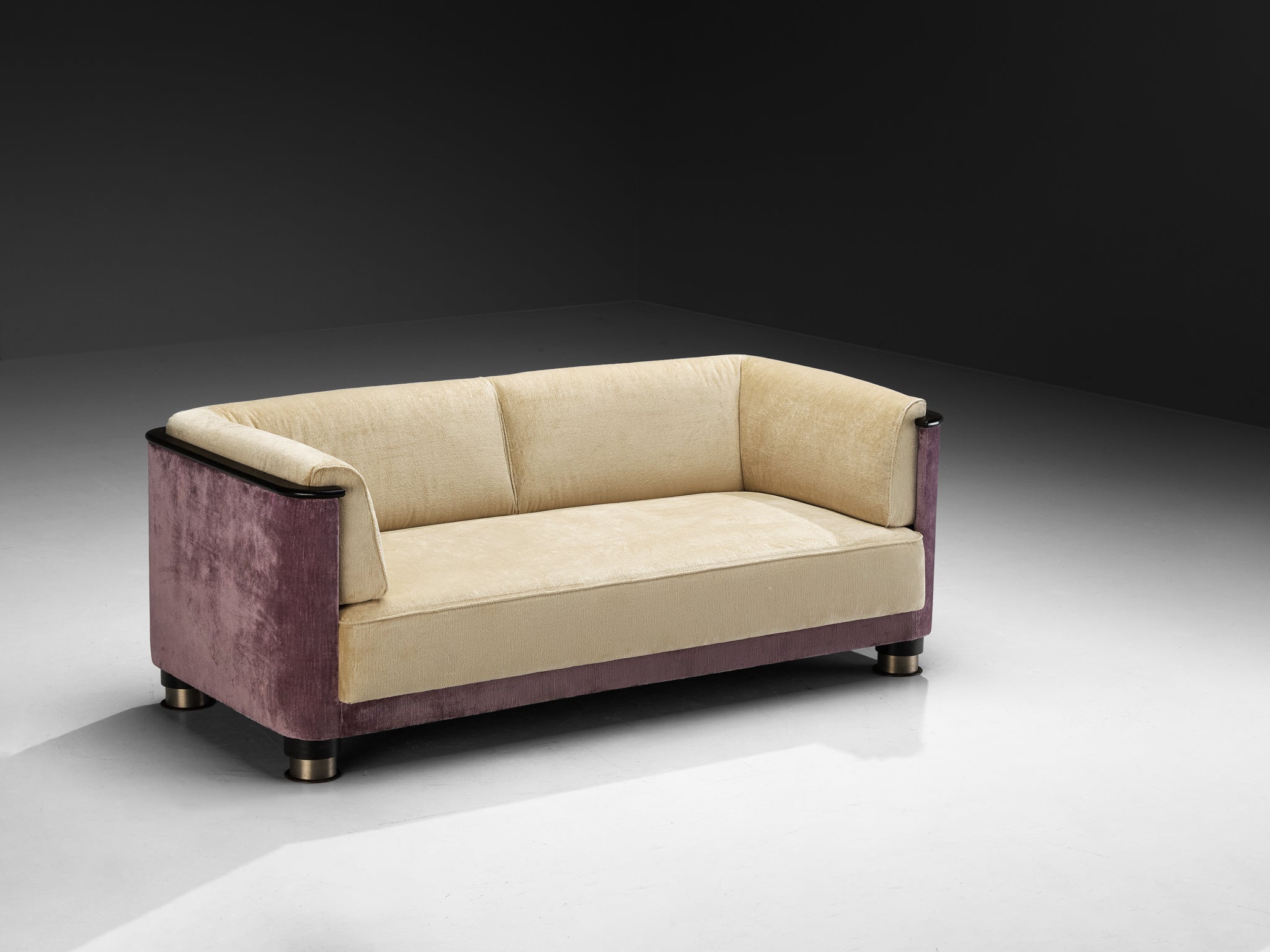
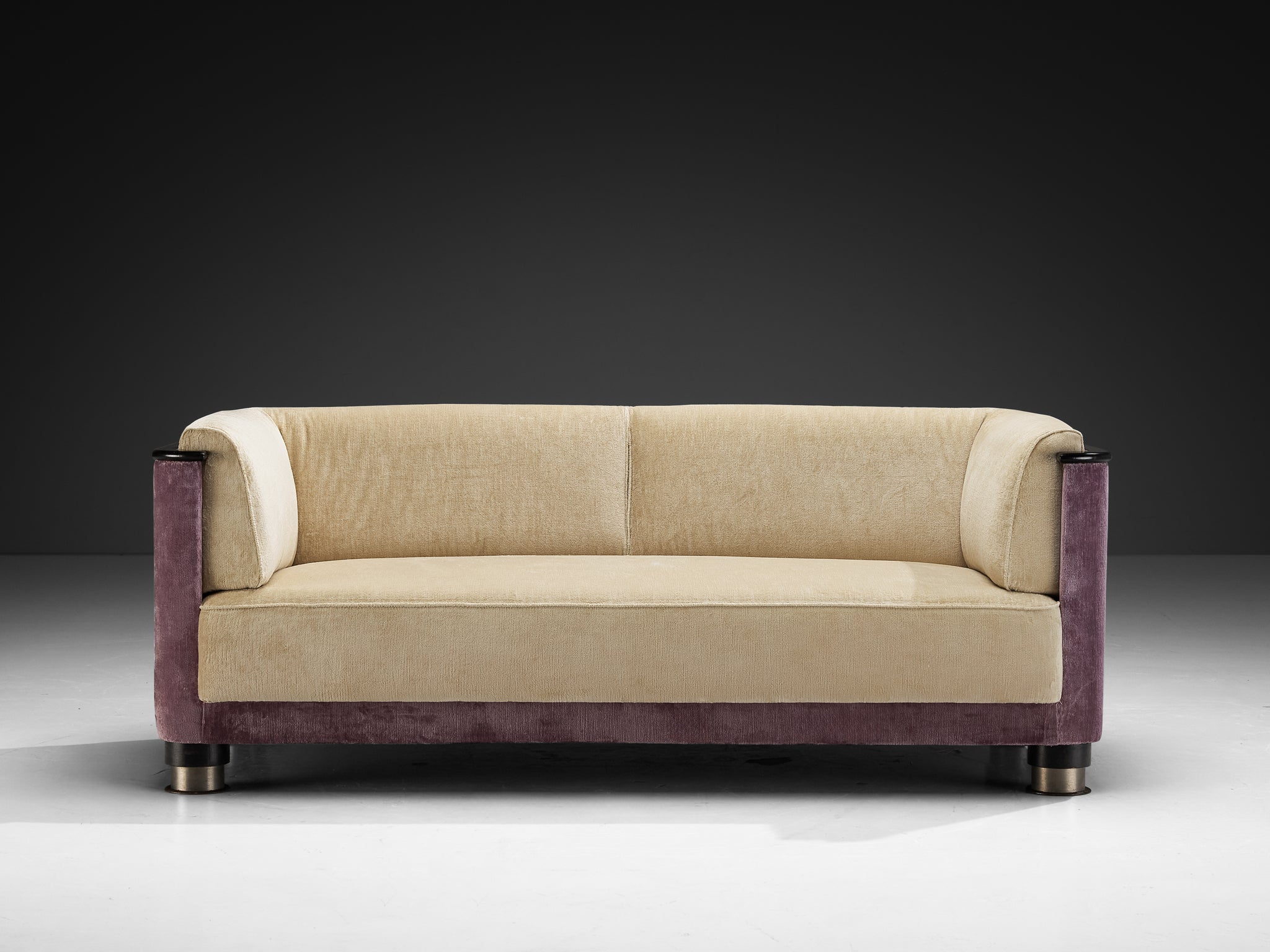
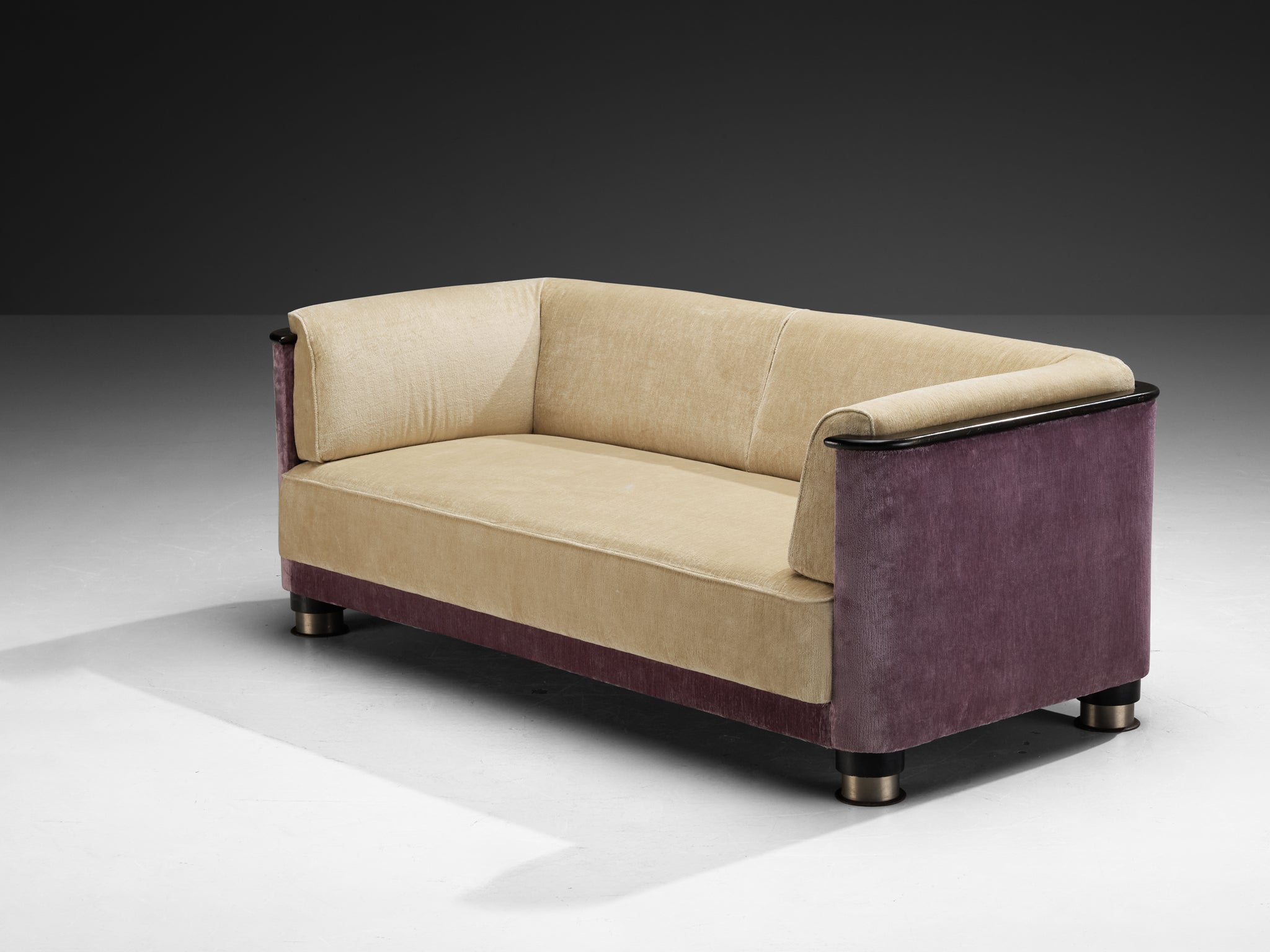

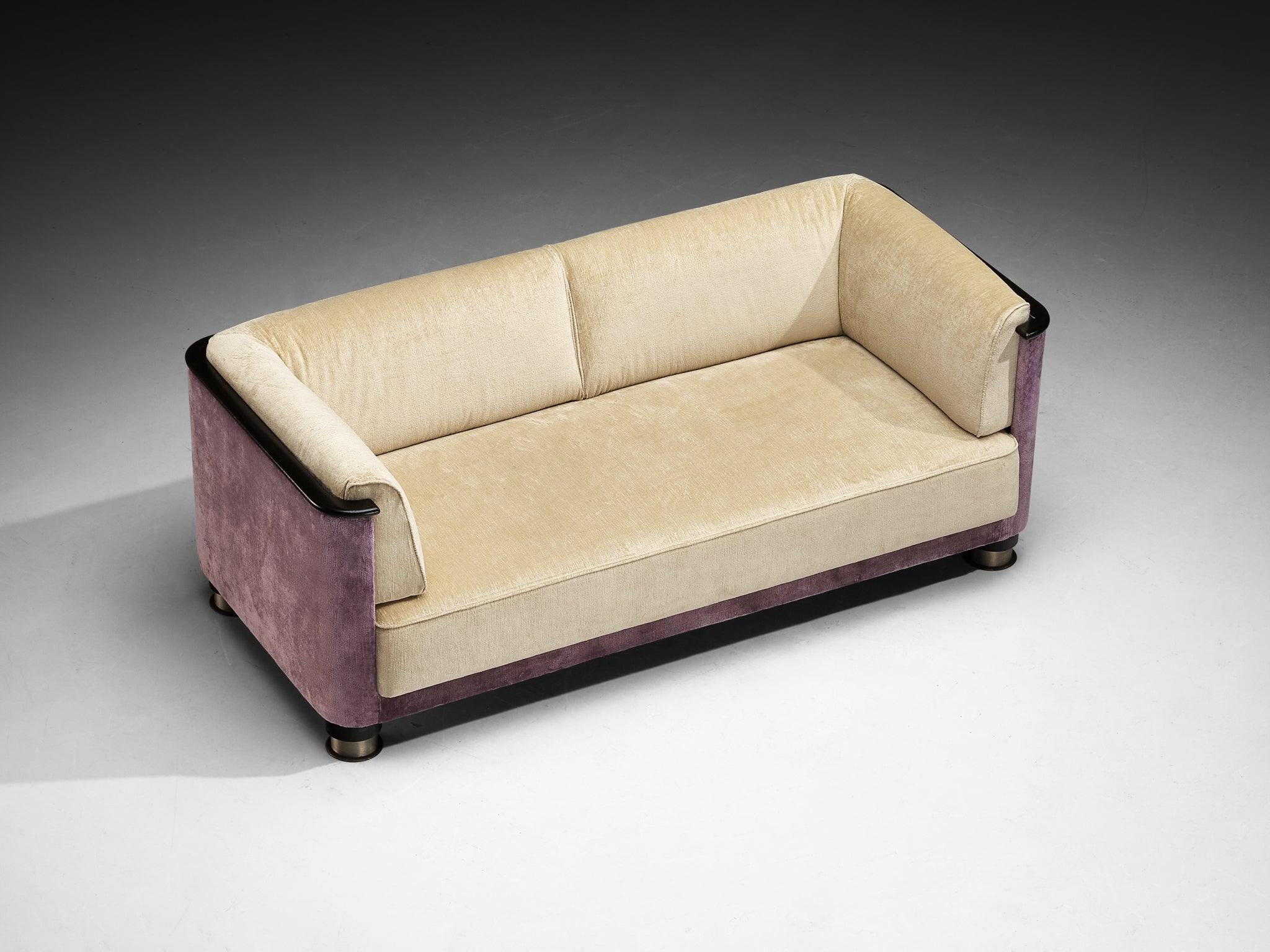
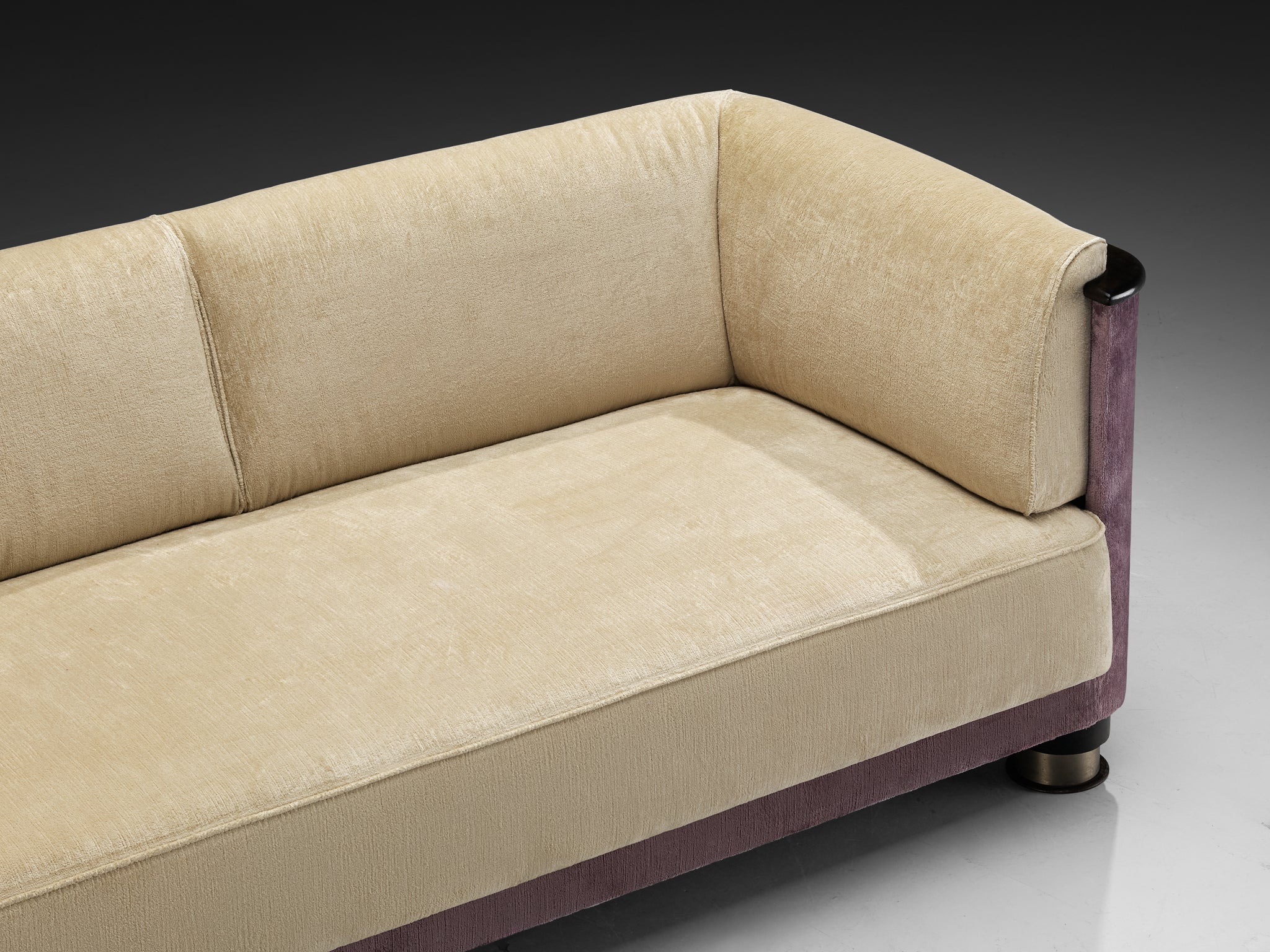
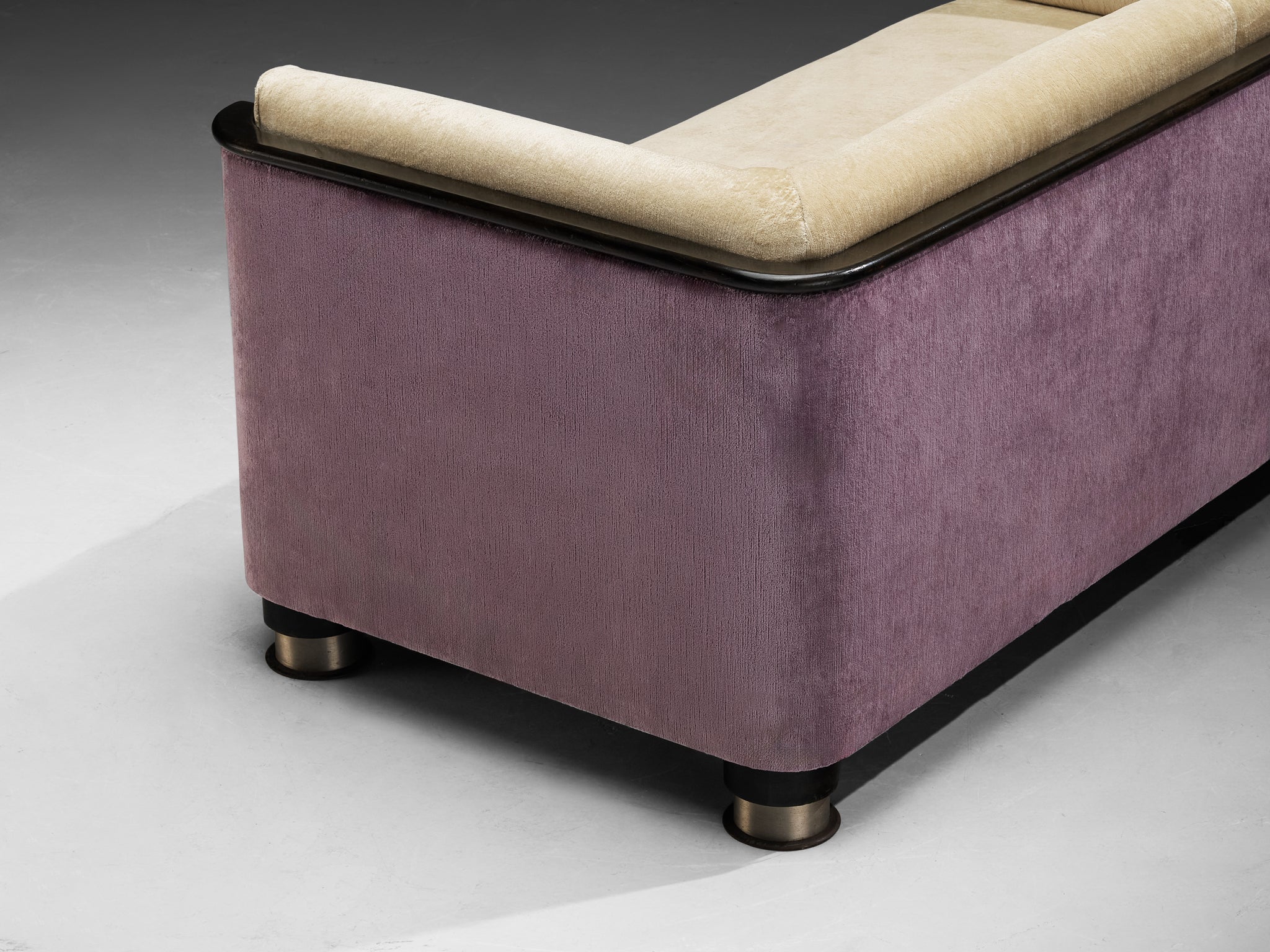
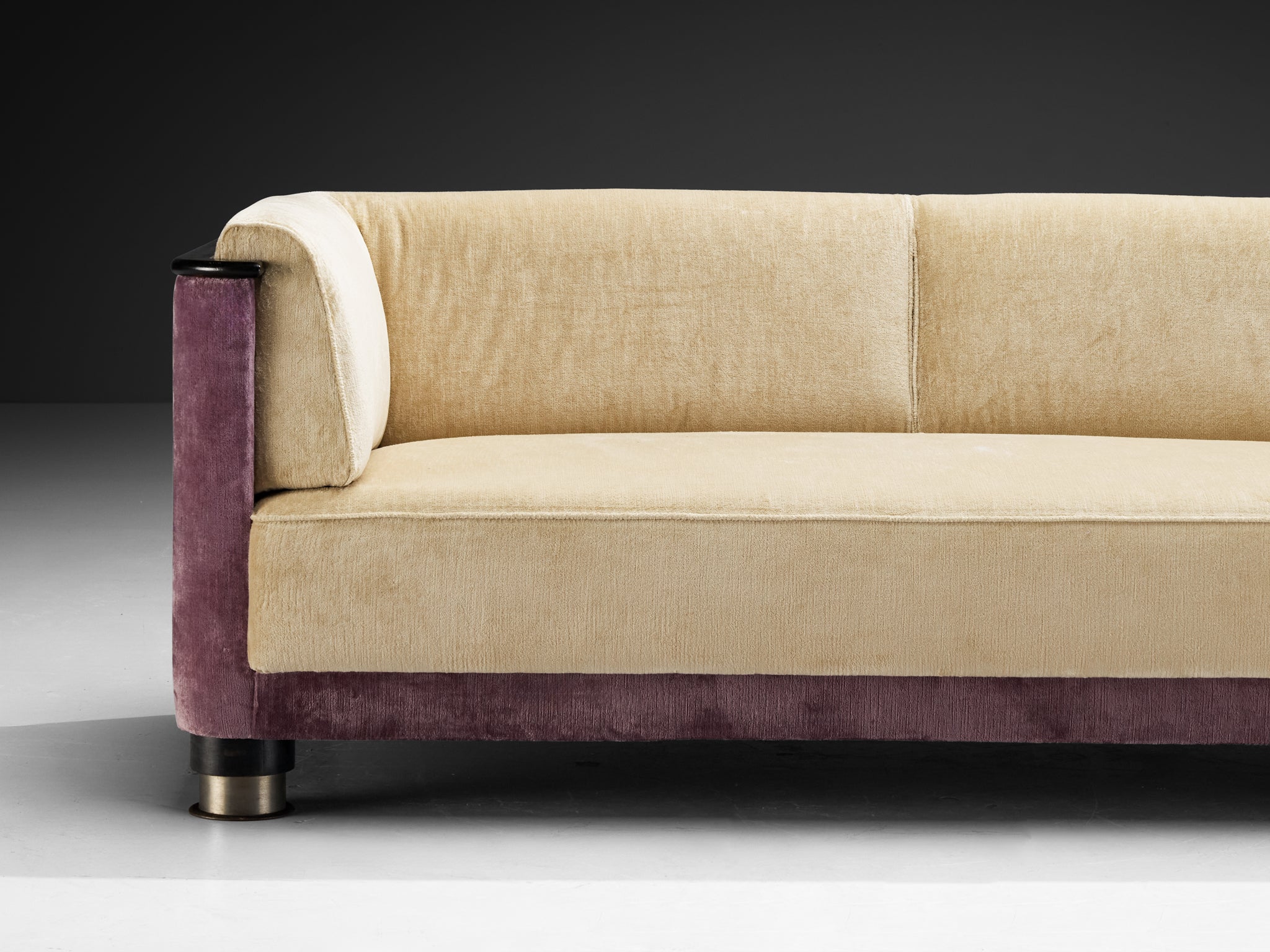
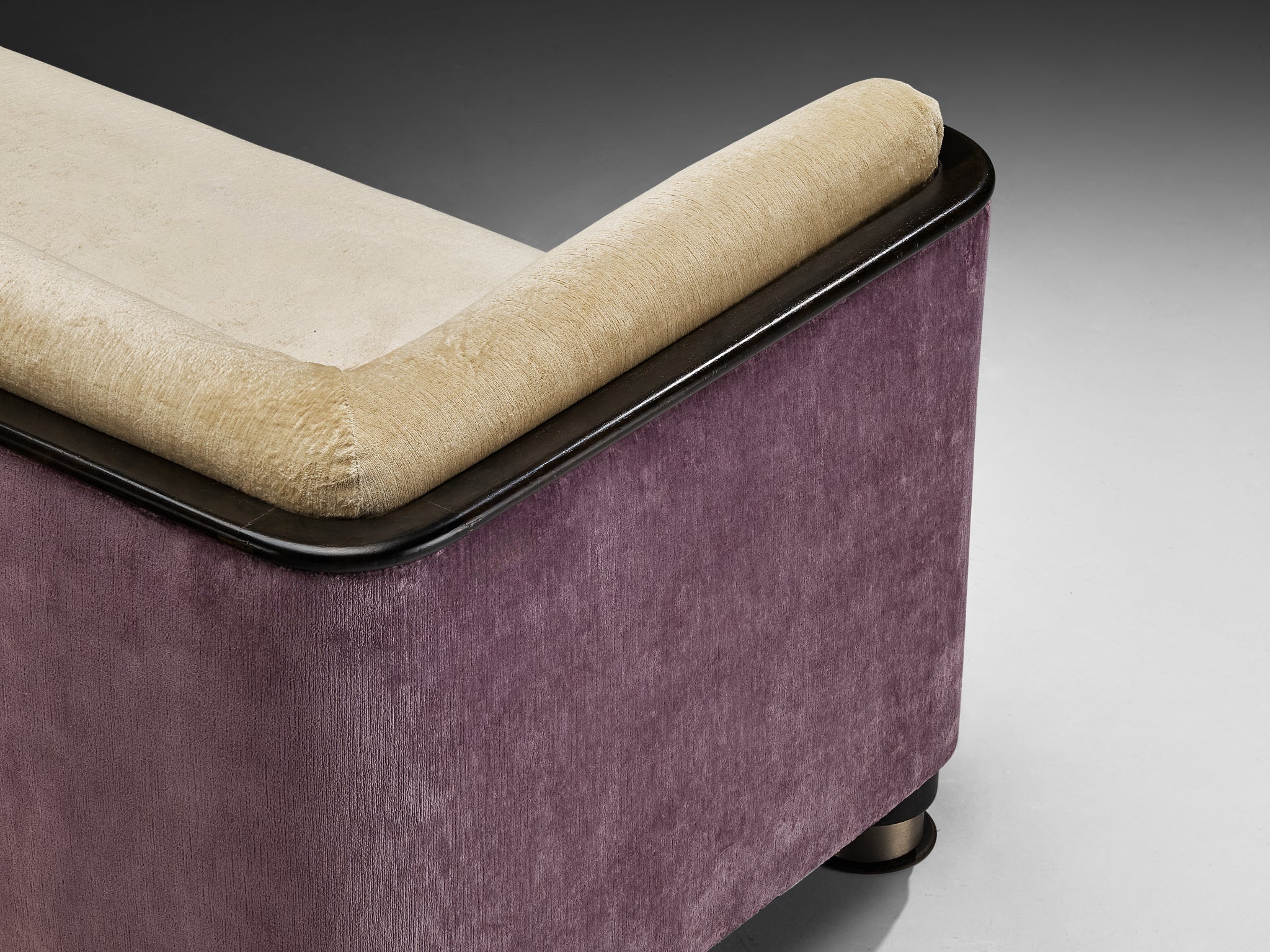
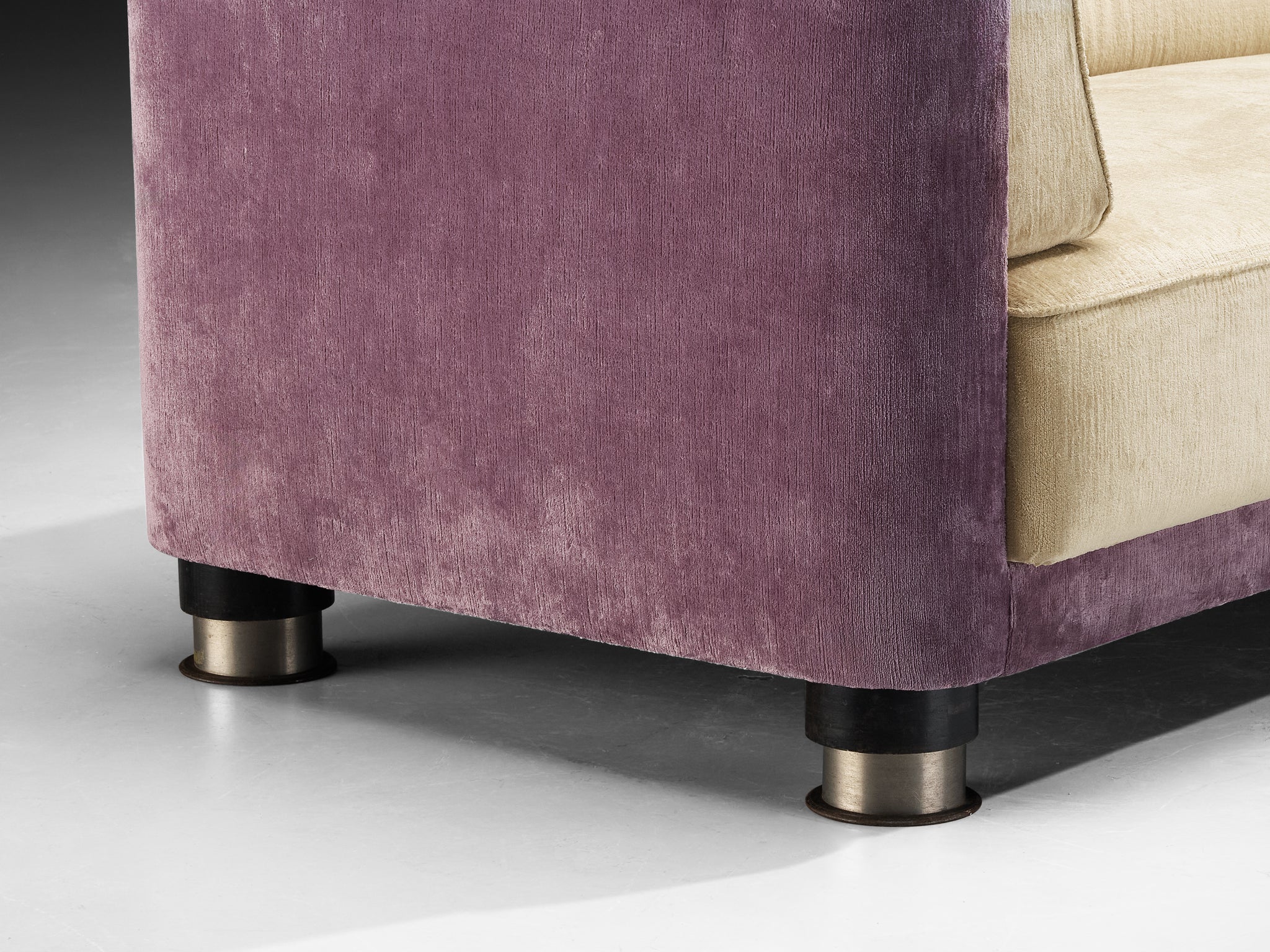
Rare Otto Schulz for Boet 'B104' Sofa circa 1935
Otto Schulz for Boet, sofa, model B. 104, reupholstered in “Georges Lilas” and “Georges Sable” by Pierre Frey, lacquered wood, nickel-plated aluminum, iron, Gothenburg, Sweden, circa 1935
This sofa, designed by Otto Schulz and produced by the Swedish company Boet, epitomizes the unique design approach that Schulz developed during the 1930s. The sofa, part of the Bo-line series, was created in Gothenburg, Sweden, and were first introduced in the Boet magazine in 1935. The Bo-line included among others a seating section, which was characterized by modular designs, allowing pieces to be combined and arranged in ways that suited the user’s preferences and needs. A defining feature of Schulz’s work, and particularly of this sofa, is his eclecticism, which often defies easy categorization. He did not shy away from decoration or symbolic elements, even in the context of functionalist furniture, a decision that often placed him at odds with strict modernists who considered decoration to be unnecessary or even taboo. The original upholstery of this sofa featured decorative fabric with flora and fauna motifs, reflecting Schulz's affinity for traditional ornate elements. His ability to combine unexpected materials – such as pairing the embellished fabric with the industrial look of metal feet – resulted in a design that was both progressive and rooted in traditional aesthetics. Additionally, the use of geometric shapes softened by rounded edges, all framed within clean lines, introduced a sense of practicality, characteristic of modernist design. Schulz’s work, including this sofa, was reflective of his broader design philosophy: a balance between the traditional and the modern, the decorative and the functional.
In central Gothenburg, one of Sweden’s most exclusive interior design shops, Firma Boet, was established during the interwar period. The store was founded in 1920 by the architect Otto Schulz, together with the Stockholm architect Adolf Nordinberg. Boet soon developed into a fully-stocked store with competitors in Sweden, and within a few decades, the shop was comparable – but also competitive – with the furnishing department at Nordiska Kompaniet or Firma Svenskt Tenn in Stockholm. In his solo efforts, Schulz continued to develop furniture designs that adapted to the changing times, and in relation to the trends of leading firms of the time, such as Swedish Grace during the 1920s and the Swedish Modern movement from the 1930s onwards. Schulz repeatedly emphasized his position as owner and artistic leader for Firma Boet. Schulz was also recognized for creating designs and individual furniture pieces featured in the firm’s magazine, Boet. However, it is likely that many other employees played a crucial role in supporting and boosting the production capabilities of the company.
The magazine Boet was a monthly magazine for home culture, crafts, and industrial art, published monthly from 1928 to 1938, with a special anniversary issue in 1945. The magazine primarily featured photographs and editorial texts about Firma Boet’s furniture and interiors, but it also contained a number of articles, reviews, and commentary. Boet enlisted a diverse group of contributors, including museum curators, theorists, critics, architects, craftsmen, designers, and representatives from the art industry. Many of these writers were actively involved in Gothenburg's cultural scene. They explored Boet from various angles, covering topics such as advancements in furniture design, architecture, interior decor, lighting, formal events, lighting fixtures, wallpapers, textiles, modern paintings, tapestries, decorative arts, and table settings.
This sofa, designed by Otto Schulz and produced by the Swedish company Boet, epitomizes the unique design approach that Schulz developed during the 1930s. The sofa, part of the Bo-line series, was created in Gothenburg, Sweden, and were first introduced in the Boet magazine in 1935. The Bo-line included among others a seating section, which was characterized by modular designs, allowing pieces to be combined and arranged in ways that suited the user’s preferences and needs. A defining feature of Schulz’s work, and particularly of this sofa, is his eclecticism, which often defies easy categorization. He did not shy away from decoration or symbolic elements, even in the context of functionalist furniture, a decision that often placed him at odds with strict modernists who considered decoration to be unnecessary or even taboo. The original upholstery of this sofa featured decorative fabric with flora and fauna motifs, reflecting Schulz's affinity for traditional ornate elements. His ability to combine unexpected materials – such as pairing the embellished fabric with the industrial look of metal feet – resulted in a design that was both progressive and rooted in traditional aesthetics. Additionally, the use of geometric shapes softened by rounded edges, all framed within clean lines, introduced a sense of practicality, characteristic of modernist design. Schulz’s work, including this sofa, was reflective of his broader design philosophy: a balance between the traditional and the modern, the decorative and the functional.
In central Gothenburg, one of Sweden’s most exclusive interior design shops, Firma Boet, was established during the interwar period. The store was founded in 1920 by the architect Otto Schulz, together with the Stockholm architect Adolf Nordinberg. Boet soon developed into a fully-stocked store with competitors in Sweden, and within a few decades, the shop was comparable – but also competitive – with the furnishing department at Nordiska Kompaniet or Firma Svenskt Tenn in Stockholm. In his solo efforts, Schulz continued to develop furniture designs that adapted to the changing times, and in relation to the trends of leading firms of the time, such as Swedish Grace during the 1920s and the Swedish Modern movement from the 1930s onwards. Schulz repeatedly emphasized his position as owner and artistic leader for Firma Boet. Schulz was also recognized for creating designs and individual furniture pieces featured in the firm’s magazine, Boet. However, it is likely that many other employees played a crucial role in supporting and boosting the production capabilities of the company.
The magazine Boet was a monthly magazine for home culture, crafts, and industrial art, published monthly from 1928 to 1938, with a special anniversary issue in 1945. The magazine primarily featured photographs and editorial texts about Firma Boet’s furniture and interiors, but it also contained a number of articles, reviews, and commentary. Boet enlisted a diverse group of contributors, including museum curators, theorists, critics, architects, craftsmen, designers, and representatives from the art industry. Many of these writers were actively involved in Gothenburg's cultural scene. They explored Boet from various angles, covering topics such as advancements in furniture design, architecture, interior decor, lighting, formal events, lighting fixtures, wallpapers, textiles, modern paintings, tapestries, decorative arts, and table settings.
Choose options










Rare Otto Schulz for Boet 'B104' Sofa circa 1935
Sale price£25,923.19
Regular price
Product Details